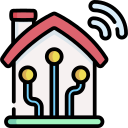Smart Lighting Automation with AI
Smart lighting automation with AI is redefining the way we interact with our living and working spaces. By seamlessly integrating artificial intelligence into lighting systems, buildings can adapt illumination to the needs and behaviors of their occupants, offering unparalleled comfort, energy efficiency, and convenience. This page explores how AI-enabled lighting systems function, their benefits, the core technologies behind them, and the future of smart illumination for homes and businesses.
Intelligent Adaptation and Personalization
Context-Aware Illumination
Context-aware illumination means that lighting adapts automatically based on environmental cues and user activity. AI systems leverage input from motion detectors, ambient light sensors, and sometimes even cameras to discern what kind of lighting is needed at any given time. This reduces the need for manual adjustments, ensuring that the right level and color temperature of light are always provided, whether someone is reading, entertaining guests, or simply relaxing.
Learning User Preferences
Over time, AI-driven lighting systems analyze patterns from user interactions, such as dimming preferences, schedules, and responses to different lighting scenes. This continual learning allows the system to anticipate user needs and proactively adjust lighting, creating an ultra-personalized atmosphere. The result is a highly adaptive environment where comfort and convenience are maximized without conscious input from the occupants.
Collaborative Device Integration
Smart lighting rarely operates in isolation. By integrating with smart home ecosystems, AI lighting systems communicate with other devices, like thermostats, blinds, and even music systems, to orchestrate a cohesive environment. This collaborative approach ensures all aspects of a space work together, such as syncing lights with audio for entertainment or adjusting brightness with window blinds for optimal daylight harvesting.
Enhancing Energy Efficiency
Gone are the days of forgetting to turn off the lights. AI systems use sensors to detect if a room is occupied and control lighting accordingly, only illuminating spaces when needed. This eliminates unnecessary energy use in vacant areas, contributing to considerable energy savings across residential and commercial buildings. With more precise occupancy detection, these systems are leagues ahead of traditional timer-based solutions.

Advanced Sensors and Data Collection
At the heart of intelligent lighting are sophisticated sensors that collect a wealth of environmental and usage data. These sensors measure factors like motion, temperature, humidity, light intensity, and even CO₂ levels to gauge the conditions within a space. The more granular and comprehensive the data, the more accurately AI algorithms can infer user needs and environmental contexts, making automated lighting both smarter and more responsive.
Machine Learning Algorithms
AI in lighting depends heavily on the ability to learn from previous data. Machine learning algorithms are trained to recognize patterns in occupant behavior, environmental conditions, and system performance. Over time, these algorithms become adept at making nuanced decisions about when and how lighting should be adjusted, learning to provide the right illumination for each situation without the need for ongoing manual input.
Cloud Connectivity and Remote Control
Cloud-based architectures provide the flexibility and scalability required for large-scale lighting automation. With cloud connectivity, users can control lighting remotely via smartphones or voice assistants, and updates to AI models can be deployed instantly. This connectivity also facilitates real-time analytics and remote diagnostics, ensuring ongoing optimization and maintenance of lighting systems.
